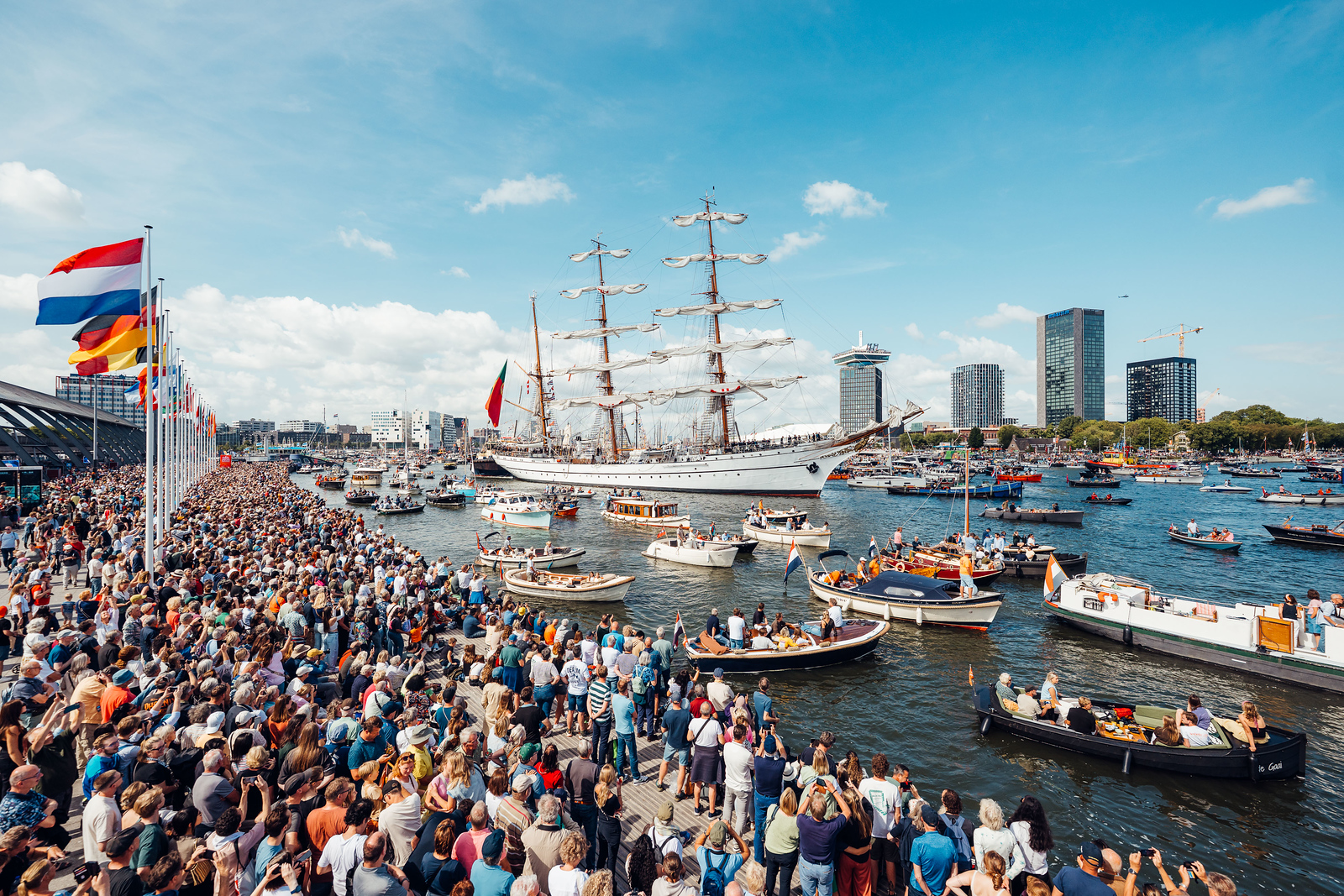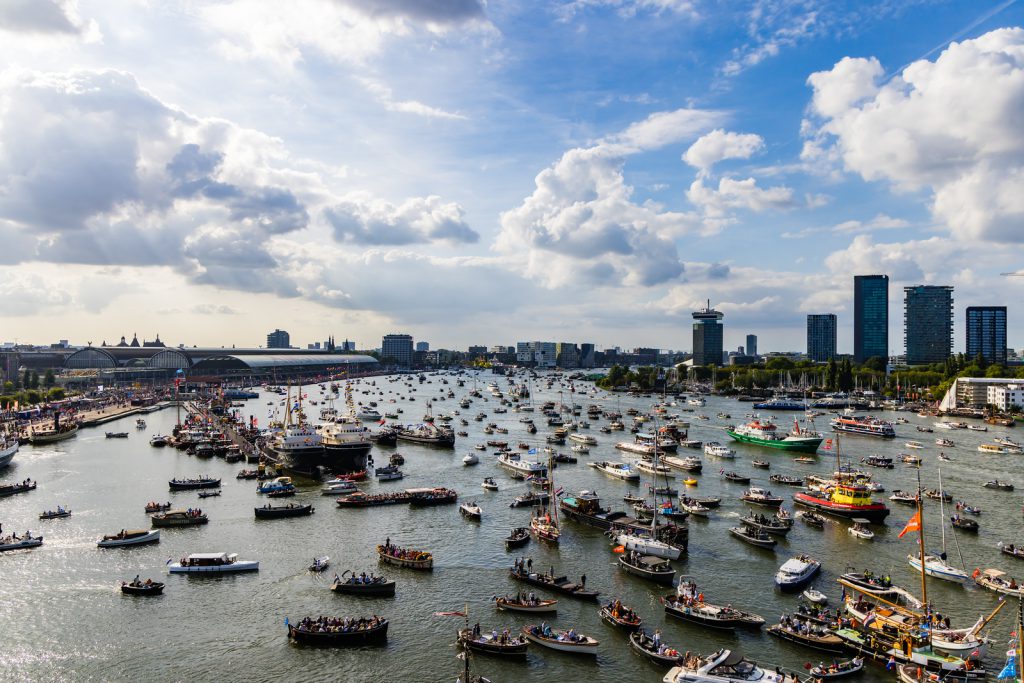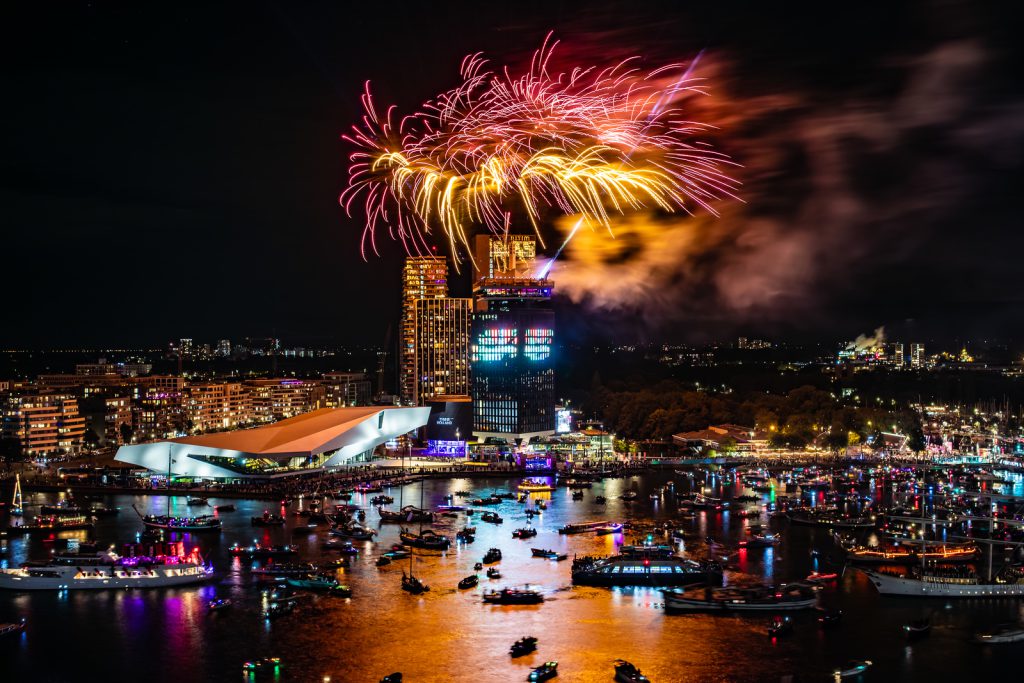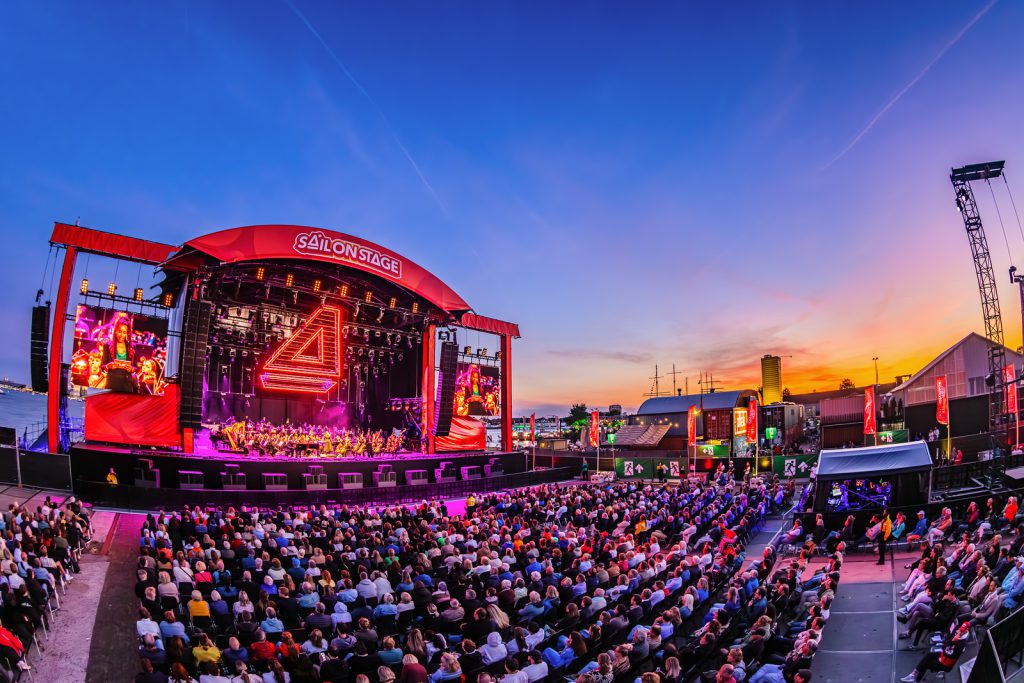

This is a published article in EB Live – October 2025—header photo credits: Martijn van Leeuwen.
With over 2.5 million visitors, more than 10,000 ships, and an unparalleled collaboration between dozens of partners, SAIL 2025 will go down in history as one of the most impressive editions ever. Joris Joosen and Marcel Elbertse (The Support Group), Huib Joor (Your Productions), Leonie Boon (Collect & Clean), Roger Meijer (ORGANIZED), and Pieter Lubberts (Backbone International) look back on this nautical event. “Six kilometers long, crowds packed deep along the quays; that image will stay with me forever.”
From August 20 to 24, SAIL returned to the capital after a ten-year absence. The tenth official edition coincided with both SAIL’s 50th anniversary and the celebration of Amsterdam’s 750th birthday. The nautical event drew approximately 2.5 million visitors over five days, offering them the chance to admire more than 10,000 ships from over twenty countries.
The crowds peaked on Saturday, when the naval ship Zr.Ms. Karel Doorman alone welcomed around 25,000 visitors. The sheer scale of the event made close collaboration with the Port of Amsterdam, Rijkswaterstaat, and local authorities essential. Maritime traffic on the IJ and the North Sea Canal had to operate safely alongside the massive flow of visitors along the quays.
For Joris Joosen and Marcel Elbertse, Managing Partners at The Support Group, the strength of SAIL starts with its unique setting.
“It’s a project that unfolds entirely in public space. You’re not building a fenced-off festival site — you’re creating a large-scale production right in the heart of Amsterdam. That’s what makes SAIL not only special but also complex. You have to take residents, shop owners, and commuters into account, all while the city keeps running as usual.”
“Our involvement in previous editions of SAIL gave us experience and insight that we were able to bring together for the 2025 edition through a close partnership with SAIL. In practice, this meant that several companies within The Support Group were involved in bringing SAIL 2025 to life. We’re incredibly proud to have made a major contribution as a Contributing Partner to the success of SAIL 2025.”
“The companies within The Support Group that had the opportunity to work on SAIL are all well-established players in the event industry, each with years of experience and a long history of collaboration,” says Marcel Elbertse. “That kind of cross-pollination creates real value — teams that normally meet each other at different festivals and events now come together in one fully integrated operation. That builds trust.”
A personal highlight for Joosen and Elbertse was the Sail-In Parade. “We had the privilege of sailing along on one of the beautiful ships and witnessing the sea of people lining the quays — six kilometers long, rows deep. That image will stay with us forever. In that moment, you truly grasp the scale and impact of the event. Hundreds of thousands of people coming together to experience something extraordinary — that energy is unlike anything else. Hats off to the entire SAIL organization. We’re extremely proud to have been part of it once again.”

For Huib Joor, owner of Your Productions, the event was above all a celebration. “It was a wonderful event. We spent a year and a half preparing the entire public catering operation, for which we were responsible. Since the previous edition took place in 2015 and the 2020 edition was canceled due to COVID, much of the existing knowledge had become outdated or disappeared altogether. That meant we practically had to start from scratch.”
That restart came with its share of uncertainties. “What are the current trends, and what kind of audience should we expect? What does their spending behavior look like? You can’t predict that using data from ten years ago. So, we conducted extensive research into consumer behavior. In the end, it turned out we made the right choices — visitors were happy with both the value for money and the variety of options available.”
The diverse audience at SAIL required a versatile approach. “During the day, you have families with children; in the evening, it’s a completely different crowd. You have to make sure you can cater to everyone. For us, that meant combining quick-service points, high-quality food and beverage options, and plenty of variety.”
His personal highlight was also the Sail-In Parade. “We worked toward that moment for so long. When it finally happened, it truly felt like the crown jewel of our efforts. At the same time, we were also running operations at Mysteryland, which made it even more special.”
For Joor, there’s no question that SAIL is one of a kind. “The location makes it extraordinary — right in the heart of Amsterdam, on the water. I’m from Eindhoven myself, where there’s only a canal. Here, you’re using massive parts of the city for nearly three weeks, including setup and teardown. And everything ran safely and smoothly, despite the hundreds of thousands of visitors. I find that incredibly impressive.”
In addition to production and catering, sustainability played a key role. Leonie Boon, Resource Coordinator for SAIL and Sustainability Manager at Collect & Clean, describes the event as a truly unique project. “In terms of atmosphere, scale, and overall experience, you don’t often encounter something like this in the Netherlands. For me personally, it was also the largest project I’ve worked on so far.”
Her team was responsible for resource management and cleaning. “Because we joined the project more than a year in advance, we were able to advise from the very beginning on procurement and material selection. Sustainability really starts with the question: what are you buying? By making conscious choices at that stage, you can prevent materials from becoming waste later on.”
SAIL set out with ambitious sustainability goals: completely free of single-use plastics, separation of five material streams, and a high share of reusable materials. At the same time, structural sustainability measures were implemented. While previous editions relied on around 95 diesel generators, this year only five were used — all running on HVO100. This biofuel reduces CO₂ emissions by up to 90% and also limits nitrogen and particulate emissions. The Clipper Stad Amsterdam launched the Sail-In Parade entirely on HVO100, and other ships were able to refuel on-site.
Water savings were achieved through circular solutions, with the most extensive toilet facilities using treated IJ water instead of drinking water, resulting in a savings of approximately 6 liters per flush. Innovative technologies, such as the CanalCleaner, removed microplastics from surface water.
To make sustainability tangible and verifiable, the organization collaborated with GSES (Global Sustainable Enterprise System) for independent monitoring and reporting. Additionally, SAIL served as a testing ground: through the In Residence Open Events 2025 program, entrepreneurs could run pilot projects with new technologies, ranging from circular materials to hydrogen-based solutions.
The operation run by Collect & Clean was intensive. “In collaboration with the City of Amsterdam, we deployed 100 staff members during the day to be visibly present, encouraging visitors to handle their waste responsibly and keep trash bins empty. At night, a team of 35 cleaners worked to restore the site. That visibility made a real difference — people are less likely to litter when they see someone actively cleaning. We also introduced recycling stations where visitors could sort and deposit their waste themselves. That worked surprisingly well.”
What stayed with Boon were the compliments from visitors. “Many people said that the site was cleaner during the day than the rest of the city. That was a clear confirmation that our approach worked. It also shows that with the right effort and collaboration, you can truly make a difference!”

Alongside production, catering, and sustainability, there was another crucial pillar: registration and hospitality, managed by ORGANIZED. CTO Roger Meijer emphasizes the scale of the operation. “It was a busy period, but that was precisely what made it exciting! We processed nearly 200,000 accreditations. That’s standard for a ticketing system, but for a back-office system, it was unprecedented. We started with volunteer registration, but were soon responsible for all other forms of registration. Every official ship on the IJ during SAIL was registered through ORGANIZED, including crew and captains, press, artists, and staff.”
“Because of this flexibility, we also played a major role in all hospitality packages, handling the B2B side — companies renting boats with their clients or employees, for example. What’s remarkable is that hardly any software adjustments were needed — smart configuration made it all possible.”
A real eye-opener for Meijer was the scale of the invitation process. “It offers huge opportunities for B2B events. The RSVP module we used is similar to Google Forms, but fully integrated into the event infrastructure. That opens doors for other projects.”
He describes the collaboration with SAIL and other partners as excellent. “We truly felt like a partner, not just a supplier. Our colleagues on-site were treated as part of the team. That allowed us to act faster together and work more innovatively. My personal highlight? Sailing into the city during the Sail-In Parade and seeing the quays packed early in the morning — that was incredible. That’s when you really see the scale and impact of an event you’ve helped bring to life.”
Finally, Pieter Lubberts, Managing Director at Backbone International, reflects on the event. For him, SAIL 2025 may have been the best edition yet. “It remains one of the most beautiful events in our portfolio. Preparations began a year in advance. Together with the SAIL management team, we discussed how the organization should be structured and how we could bring their ideas to life from a production perspective.”
The urban environment made the operation particularly challenging. “You can’t just reuse the playbooks from previous editions. The city has changed, and SAIL takes place right in the middle of a functioning urban area. That makes it large-scale, complex, and logistically demanding.”
At the same time, this edition allowed room for innovation. “New techniques were applied in crowd management due to limited staff availability. For Backbone, the focus was on energy supply: less diesel, more fixed power and battery solutions. This aligns with SAIL’s sustainability ambitions and is a development we plan to continue in other projects.”
His personal highlight was also on the water.“I’ve been part of every edition, but this was the first time I could experience it from a boat. You see the joy on people’s faces, feel the energy, and are reminded why SAIL is so special.”
